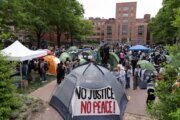This year marks the 100th anniversary of the Tulsa race massacre of 1921, but unless you watched HBO’s “Watchmen” (2019), the majority of Americans sadly haven’t heard of it.
That’s about to change thanks to Dawn Porter’s new documentary “Rise Again: Tulsa and the Red Summer,” which airs on the National Geographic Channel this Friday at 9 p.m.
“It’s a chapter in history a lot of people don’t know about,” Washington Post reporter, University of Maryland professor and on-screen narrator DeNeen Brown told WTOP.
The film starts by showing what led to the massacre after a horrific string of attacks in various cities across the country in what became known as the Red Summer of 1919.
“The 1921 Tulsa race massacre didn’t happen in a vacuum,” Brown said. “Red Summer, which occurred in 1919, was a reign of terror that included massacres in Washington D.C., Omaha, Nebraska and Elaine, Arkansas [where] historians say as many as 800 Black people were killed by white mobs who hunted Black people down and shot at them.”
Before the massacre, Tulsa’s booming oil industry built the prosperous all-Black community of Greenwood, which Booker T. Washington called “Negro Wall Street.”
“It had a population of 10,000 people, luxury shops, 21 restaurants, 30 grocery stores, a Black-owned hospital, library, a savings and loan, three hotels, jewelry stores, clothing stores, Black millionaires who owned oil wells … and in a matter of two days, it was all destroyed,” Brown said. “The 1921 Tulsa race massacre left 35 square blocks smoldering.”
It all started with an incident at the Drexel Building on May 30, 1921.
“Tulsa was a hotbed for the Klan; they were just waiting for a spark,” Brown said. “A Black teenager, Dick Rowland, a shoeshiner, went to use the restroom. … He got on an elevator operated by Sarah Page, a white girl about 17. He may have bumped her, or some historians say they were in love. … When the doors opened, Sarah Page shrieked.”
Rowland was arrested and taken to the courthouse as a crowd gathered outside.
“The Tulsa Tribune ran a headline that said, ‘Nab Negro for Attacking Girl in an Elevator.’ a whistle call to the white mob,” Brown said. “They demanded that Dick Rowland be released so they could lynch him. Black veterans marched to the courthouse to defend Dick Rowland. A battle ensued, a shot went off, a white man is hit, and all hell breaks loose.”
The Tulsa race massacre began on May 31, 1921 and ended on June 1, 1921. As many as 300 Black people were killed, more than 800 were injured and more than 1,200 Black-owned homes and businesses were destroyed, leaving 10,000 Black people homeless.
“Eventually, the white mob descends on Greenwood, this all-Black community in Tulsa, and the white mob begins shooting Black people indiscriminately, burning their houses, burning their businesses and dropping turpentine bombs on their community,” Brown said.
One survivor recalls her mom saying, “See the flag on top? Your country is attacking you.”
“The governor called in the National Guard,” Brown said. “The Black people who survived the attack were rounded up at gunpoint and marched through the streets to internment camps … at the Fairgrounds at McNulty Park. … There were Black bodies lying in the street … dumped into mass graves or piled onto trucks or trains and taken out of town.”
Tragically, the event was covered up for decades by city and state officials.
“There was a concerted conspiracy of silence to keep it out of textbooks,” Brown said. “The curator at the University of Tulsa’s library came to work in 1980 and noticed that someone had taken a razor to periodicals and cut out any magazine article that talked about it. … City officials called it an embarrassment and they deliberately set about covering it up.”
In fact, the current mayor of Tulsa, G.T. Bynum, didn’t know about it until 2001 after five generations of his family living there. So, he ordered the excavation of mass graves.
“Where are the bodies?” Brown said. “The city of Tulsa began searching for mass graves in 2019. It actually found a mass grave in Oct. 2020 in Oaklawn Cemetery. … Just last week, scientists went into the mass grave and began exhuming the remains. As of today, they found as many as 28 coffins in a mass grave, which is a pit of unmarked graves.”
Could there be more mass graves elsewhere in Tulsa?
“They did ground-penetrating radar, and in Dec. 2019, they found anomalies under the ground that look like mass graves, so they’ll be searching a site called The Canes, then Booker T. Washington Cemetery,” Brown said. “The mayor of Tulsa has gotten calls from other mayors who say they are watching Tulsa for a blueprint on how to investigate.”
In addition to the horrific loss of life, there is also the loss of generational wealth.
“These were Black people just years after the Civil War out of enslavement who built black towns, wealth and prosperity, but because of economic envy by white mobs, communities were destroyed,” Brown said. “White people felt Black people should not have this kind of wealth. … There is a demand by descendants that city officials pay reparations.”
Like anything, public awareness is the first step toward justice.
“Last year, ‘Watchmen’ was released on HBO and a number of viewers wrote to star Regina King, saying, ‘Did this really happen?’ … She tweeted out one of my stories and said, ‘Yes, it was real,'” Brown said. “Hollywood is bringing these stories out into the open and these documentaries are showing people what happened in this period of history.”
Listen to our full conversation here.








